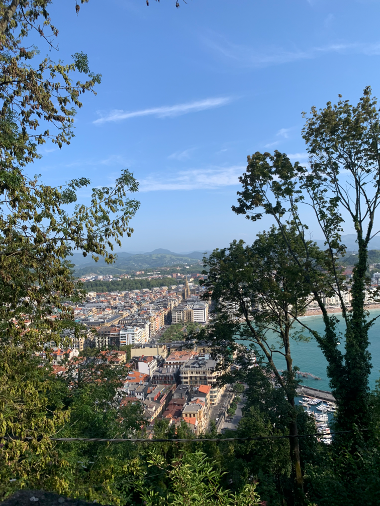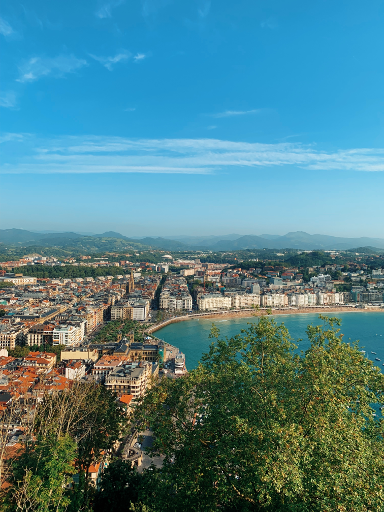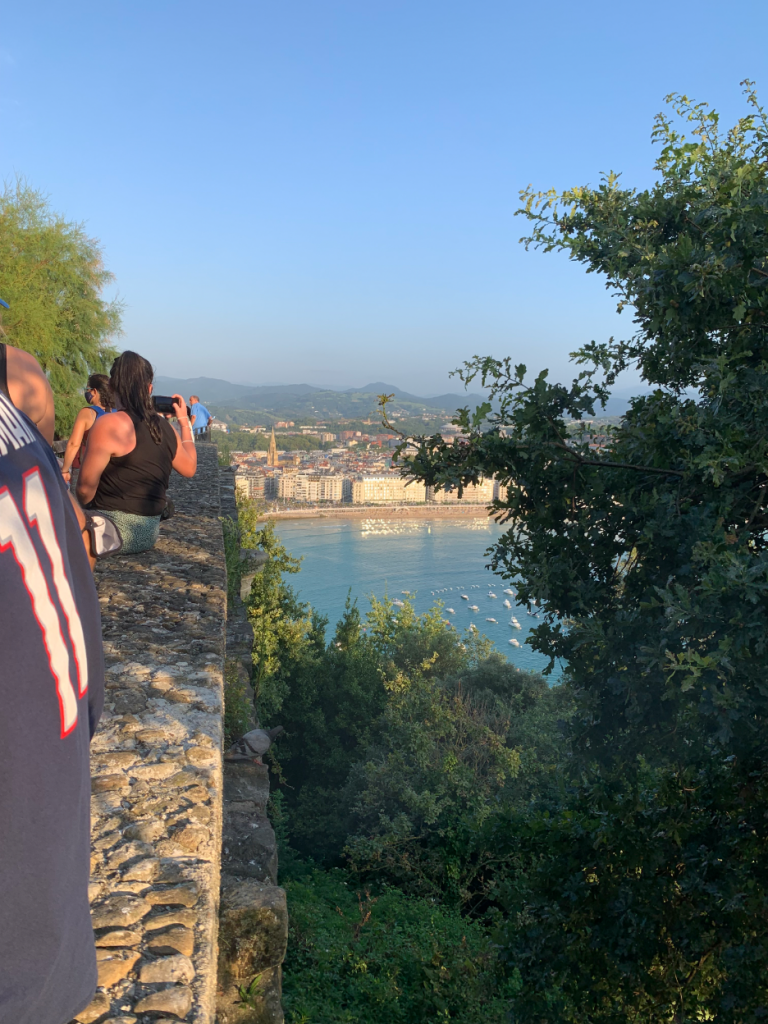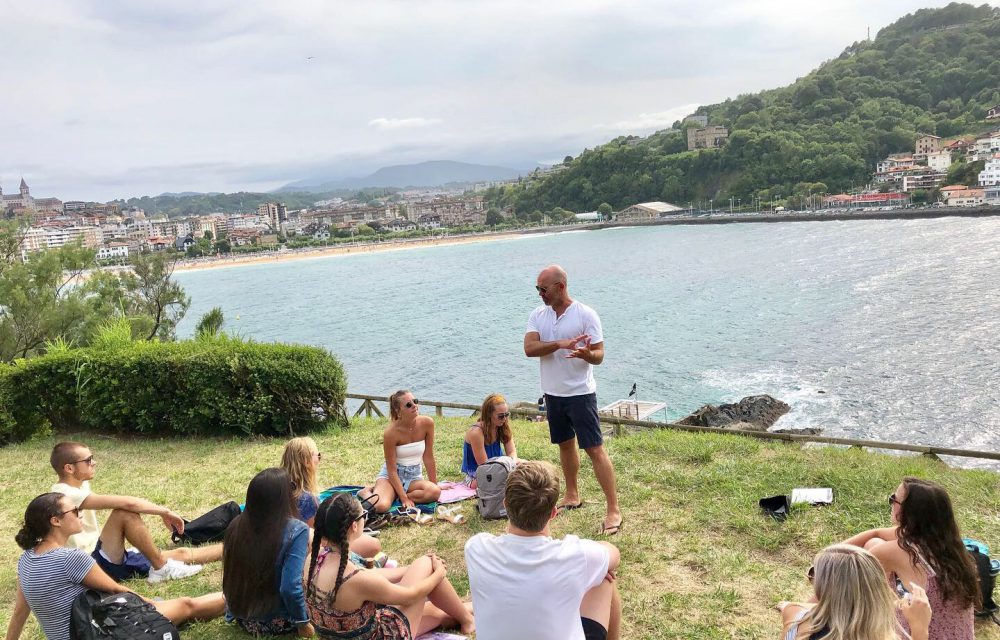We walked out into the hot sun after finishing class at Lacunza and made our way to our first destination of the day – La Concha. We hopped on our burning hot bike seats and pedaled as fast as we could to the beach, hoping to soak up as much of the ocean as possible before our excursion later in the day. We waded in the ocean, avoiding the towering waves as much as possible. Occasionally, we would all glance up at the endeavor that awaited us – looming over us was the unmistakable figure of Jesus Christ that marked the top of Mount Urgull.
After a few hours of swimming, tanning, and eventually napping at La Concha, we gathered our things and headed to meet Professor Z at the bottom of the stairs leading to the mountain. I will admit, I was nervous for the journey up the mountain. From the streets of San Sebastian, Mount Urgull looks daunting – a large, luscious green dome with a small, spiraling gap in the greenery to allow for foot paths to the top. We began our ascent with 4 flights of stairs, which foreshadowed the rest of our journey. We opted for the steeper stair route as opposed to the more gradual path, ultimately shaving off about 10 minutes from our climb. Occasionally, a clearing in the trees would allow for a glimpse of the view that would only get better the more we climbed, providing us great encouragement to continue up the slightly misshapen stairs.

Views of the city, seen in between clearings in trees on the climb up Urgull.
The climb ended up being not nearly as bad as any of us expected. Upon reaching the base of the statue of the Sacred Heart, we were rewarded with a view of San Sebastian that never seems to get old. Sprawling mountains provide a backdrop to the bustling city below, the deep blue water of the Atlantic ocean that we were swimming in just an hour before was now crashing against the city walls hundreds of feet below us.
To our surprise, we were not done climbing yet. We continued into the fortress at the base of the Sacred Heart, which contained artifacts, descriptions, and even a model of “The Old Part” of San Sebastian in 1813. Here, we discussed the history and industry of the Basque country. The Basque were some of the first whalers of their time, with their use of bacalao (salted cod) allowing them to venture into the Atlantic for long periods of time. Whaling required sailors to hunt in freezing temperatures, even 30 seconds in which could be deadly. The reward for their work, however, seemed to outweigh the risk. Every part of the whale could be used: its blubber for oil and lamps, its baleen for corsets, and its meat as a food source. Although the Basques were eventually pushed out of the whaling industry and industry slowly moved outside of San Sebastian, the Basque country continues to dominate trade and exports for Spain; including soap, chocolate, tobacco, beer, and concrete.
It is amazing what we were able to see in the 3 minutes that we were allowed at the very top of Mount Urgill. In just three minutes, we took in a panoramic view of all that the Basque country has to offer: the vast ocean that provides us refuge from the August heat and fresh, delicious seafood for dinner, the city whose people, architecture, restaurants, and markets have shown us an entirely new way of living, and the mountains that once served to protect the city now allow us to look down on San Sebastian and reflect on what its people have overcome.

San Sebastian as seen from the top of Mount Urgull.
After abdicating our throne atop San Sebastian, we retreated to a more secluded area to discuss Gabriel Urza’s All That Followed. With a gorgeous view of the city behind us, we reflected on the history of the Basque country and Urza’s ability to portray the sociohistorical and political struggles of the Basque people in his novel. All That Followed is a novel based off the real kidnapping and murder of a Spanish politician by the Basque separatist group ETA. ETA, a group formed by university students during the Franco era, ultimately turned violent and became known as a terrorist organization and killed over 500 people before their cease fire in 2010. While you cannot solve violence with more violence, ETA did at times represent the beliefs of many Basques, and, before they started committing more senseless crimes, ETA was supported by many. The Basque people were extremely oppressed by the Spanish government, at times becoming so discriminated against that speaking their native language outside the home was too dangerous. Basque country was the most policed region in Spain, and “terrorism” was the excuse used by the Spanish to justify the arresting, killing, and torture of hundreds of Basques. Reading All That Followed gives insight into the mindset of many Basques during this time, which was one set in a foundation of tight-knit community. Basques held tightly on to their culture that was being attacked and made it difficult for those who didn’t speak Basque to be accepted as one, no matter how long they’ve been living in the region. This mindset seems to still stand today, as Basques seem to be a very proud community and not afraid to show it.

After spending only a week immersed in Basque culture and its people, it is devasting to know that this beautiful region was once extremely oppressed and its language almost destroyed. Now, it is beautiful to climb to the top of Mount Urgull and be looking out at a thriving autonomous community bursting with tourists and students looking to appreciate the Basque culture. Instead of being a language that was afraid to be spoken, Basque is now sought out to be learned and kept alive by the youth in the community. It is refreshing to know that such a strong culture is being preserved instead of destroyed.
